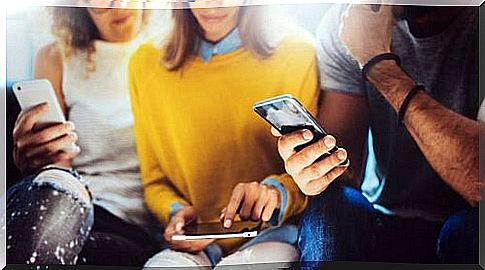Experiential Avoidance Disorder And Smartphone

Experiential avoidance disorder is one of the central concepts in third generation therapies, particularly acceptance and commitment therapy. It is a fairly common ailment in today’s society, especially taking into account the fact that we live in the culture of well-being and immediacy.
So, in experiential avoidance disorder, the only thing you want is immediate well-being, even if it’s a fleeting glare. You may be wondering what is wrong with heading towards this hedonism. Perhaps the moment has not acquired value in the face of an infinite and indeterminate life experience?
But this is precisely where the problem lies, that is, in the ideas that culture and society try to inculcate in our minds. We are constantly told that we must be happy, avoiding any discomfort, even the smallest and insignificant.
The imperative is: “Deny negative emotions, do not tolerate discomfort, always be happy” . In this sense, new technologies help us lead a more comfortable life, and perhaps make us think that this is the solution to our problems. One of all, the smartphone.
Does anyone by any chance remember when our grandmothers had to wash clothes by hand and hang them out to dry in the sun? Today we have a washing machine and a dryer. And when, to talk to someone on the phone, you had to wait to be at home and call from your landline? Water under the bridge: now we have the smartphone and WhatsApp.
However, inevitably, technological progress has made us less tolerant and less flexible. It has accustomed us to having everything, so much so that we can’t bear the rare moments when it doesn’t.

How does the mobile phone fuel experiential avoidance?
The smartphone is a useful device, which, when used wisely, is able to meet many of our needs. Inside, there are data and information that contain important pieces of our life, such as work, personal life or studies. When we lose our mobile phones, we also lose many useful and in some ways indispensable resources: contacts, notes, messages, photos, etc.
The problem is that it has become a tool that pushes us straight into experiential avoidance. The comfort it offers us is so great that we end up becoming intolerant to uncertainty, non-immediacy and non-information.
For example, who hasn’t gotten angry when their partner doesn’t reply right away on WhatsApp? Or, if we want information about someone who is part of our network of contacts, just look at their Instagram profile. There is no need to make a phone call, or to meet for a chat.
The smartphone makes us impatient, but patience is a precious quality. Even if we have such a powerful tool, we shouldn’t stop moving physically and living a sometimes uncertain life, where rewards and reinforcements only come with time. The cell phone gives us a false sense of control that completely changes our perception of things.
One of the consequences of this mechanism is that you end up being addicted. The smartphone then becomes a tool to mask the discomfort we loathe so much. This leads us to avoid the experience with the real world, with its strengths and weaknesses and, consequently, to live a little less.
What can we do to defend ourselves?
If we feel that our smartphone addiction is only increasing and that we have a tremendous need to feel stimulated, relieve uncertainty, know the results and stay constantly updated, it is time to act.
First of all, we must be aware that this well-being lasts for a very short time, only a few minutes or at most a few hours. That’s why we keep looking at the phone.
Checking the phone every minute only reinforces our intolerance and impatience. And sometimes this is a stumbling block when it comes to learning to manage unpleasant emotions.
Therefore, the first strategy will consist in carrying out a stimulus control. For example, you could set times to dedicate to your smartphone, social networks, emails or calls. If you feel like looking at your phone outside these hours, try delaying the pulse for another five minutes to distance yourself from the desire and need for control.
Another strategy is to avoid the use of apps you don’t need or reduce their use to just one hour of the day or week. The idea is to detoxify for a while, to show ourselves that we can live without electronic devices.
Finally, try to leave your cell phone at home when you go out on an errand and are not waiting for important calls, and see the result. For example, in the supermarket, when you find yourself in a queue for the cashier, instead of pulling out your phone, you will enjoy the experience of doing nothing.
Are you a victim of smartphone experiential avoidance?
Does this seem difficult advice to put into action? If you think so, you are perhaps a victim of smartphone experiential avoidance. Therefore, it is time to do something. How about discovering new ways to have fun without technology?









